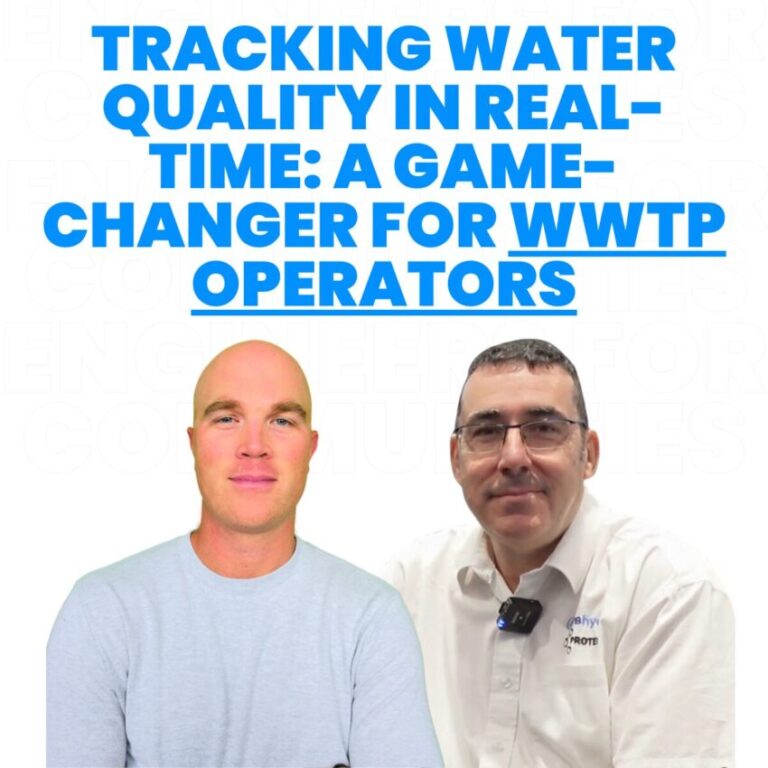Real-Time Water Quality Monitoring Using Proteus Fluorescence Technology
Introduction
In this episode, we engage with Michael Malone from Proteus, who provides comprehensive insights into advanced water quality monitoring solutions that transform environmental assessment and regulatory compliance. We explore how fluorescence-based sensor technology brings proven laboratory analysis capabilities directly to field applications, enabling real-time monitoring across diverse water systems. These innovations eliminate traditional sampling delays while providing continuous data streams essential for process control, regulatory reporting, and pollution source identification. Join us as we examine how Proteus technology addresses critical monitoring challenges facing municipal operators, environmental consultants, regulatory agencies, and industrial facility managers.
Laboratory-Grade Fluorescence Technology in Field Applications
Michael introduces Proteus’s approach to field-deployable water quality monitoring, which leverages scientifically proven fluorescence technology that has served laboratory applications for decades. The core innovation lies in proprietary algorithms that correct for background interference factors such as Tryptophan, enabling accurate field measurements without controlled laboratory conditions. This “lab in a sensor” methodology eliminates the traditional cycle of sample collection, laboratory transport, and five-day analysis periods that delay critical decision-making. The technology integrates multiple sensor capabilities into single monitoring units, including temperature and other parameters, creating comprehensive monitoring stations that provide immediate water quality assessment across diverse applications and environmental conditions.
Flexible Data Acquisition and Remote Monitoring Capabilities
The monitoring systems offer configurable data collection intervals ranging from standard 15-minute reporting to minute-by-minute sampling for detailed process monitoring applications. Michael explains that while environmental water quality typically changes hourly, the technology provides flexibility to capture rapid variations when necessary. Deployment options include standalone data logging configurations using RS-232 or Modbus protocols for integration with existing SCADA systems. Battery-powered remote installations enable months of unattended operation in locations without power infrastructure, expanding monitoring capabilities to previously inaccessible sites. This flexibility allows contract operators managing multiple systems to make morning adjustments and observe results by midday rather than waiting for next-day laboratory confirmation.
Universal Application Across Water System Types
Proteus sensors demonstrate remarkable versatility across water system applications, operating effectively in any aquatic environment including influent and effluent monitoring, industrial discharge assessment, municipal system oversight, fresh water, brackish water, seawater, drinking water, and recreational water monitoring. Michael emphasizes the technology’s universal applicability with the simple criterion “anywhere it’s wet.” This broad compatibility makes the sensors valuable for comprehensive monitoring programs spanning multiple system types and regulatory frameworks. In the United Kingdom, these sensors support the Environment Act’s national water quality mapping initiative through deployments on pump systems, data logging stations, buoys, and fixed monitoring installations, demonstrating their reliability in large-scale environmental assessment programs.
Point Source Pollution Detection and Regulatory Enforcement
The technology excels in pollution source identification applications, enabling environmental managers to systematically trace contamination sources through strategic sensor deployment and temporal monitoring patterns. Michael describes successful case studies where operators tracked pollution events by monitoring upstream locations and identifying contamination timing patterns. This capability proves invaluable for regulatory enforcement, as demonstrated in cases where systematic monitoring revealed illegal agricultural discharge without proper permitting. The ability to pinpoint specific pollution sources reduces investigation timeframes while providing concrete evidence for regulatory action, protecting water resources and ensuring environmental compliance across watersheds.
Industrial Discharge Monitoring and Municipal Protection
Proteus sensors enable municipalities to independently verify industrial discharge compliance and identify unauthorized contamination sources affecting their treatment systems. The technology supports dual monitoring approaches, assessing both industrial discharge quality and influent contamination levels to determine pollution source responsibility. This monitoring capability protects municipal treatment facilities from industrial contamination that could disrupt operations or create compliance violations while ensuring fair allocation of treatment costs based on actual discharge characteristics. Environmental managers can deploy sensors downstream from industrial facilities to verify reported discharge quality or upstream to assess background contamination levels affecting overall system performance.
Process Control Integration and Operational Efficiency
The real-time data streams enable direct integration with process control systems, allowing operators to make immediate adjustments based on current water quality conditions rather than historical laboratory data. SCADA system compatibility ensures seamless integration with existing plant control infrastructure, enabling remote monitoring and automated response protocols. This capability transforms water quality monitoring from reactive problem identification to proactive process optimization, improving treatment efficiency while reducing operational costs. Operators can identify process variations immediately and implement corrective actions before conditions impact final effluent quality or regulatory compliance.
Conclusion
This episode of “Engineers for Communities” demonstrates how Proteus fluorescence monitoring technology addresses fundamental challenges in water quality assessment and environmental protection. Through our discussion with Michael Malone, we discover how laboratory-grade analysis capabilities deployed in field applications enable real-time decision-making, pollution source identification, and regulatory compliance monitoring. These technological advances represent more than monitoring improvements; they provide the foundation for proactive water resource management, environmental protection, and data-driven operational decision-making that addresses critical challenges facing water utilities, regulatory agencies, and environmental management professionals across diverse applications and jurisdictions.

